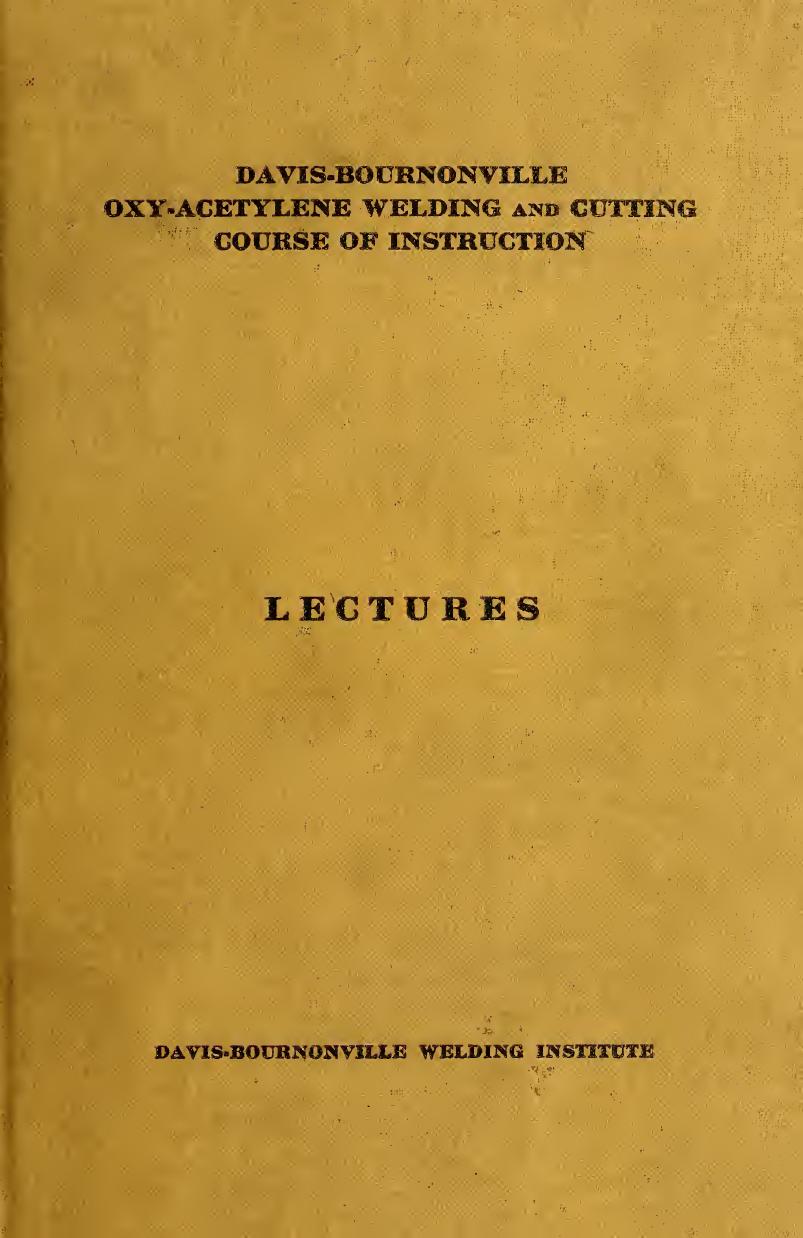Davis-Bournonville oxy-acetylene welding and cutting course of instruction. Lectures. Welding and cutting with the oxy-acetylene torch by Davis-Bournonville Institute

Author:Davis-Bournonville Institute
Language: eng
Format: epub, pdf
Tags: Welding
Publisher: Jersey City, N.J., Davis-Bournonville Institute
Published: 1919-03-25T05:00:00+00:00
maintain this relation throughout until the job is finished. It
fig; 6 COMPARISON OF PREPARATION
FIG. 7 FOR VERY HEAVY SECTIONS
Copyright 1919, by Davii-Boumonville Co,
Davis Bournonville Institute
SHOWING METHODS OF PREPARING THIN AND THICK METAL FOR WELDING
would not pay, of course, to resort to this expedient on thin sections but on thick sections it will save much time, labor, adding material and gas. .
No Beveling Required on Thin Aluminum Castings
Cast iron and steel, as already stated, should be beveled at an angle of 45 degrees on each edge, making the included angle about 90 degrees. Aluminum need not be beveled so much as the lesser angle will work satisfactorily in most cases. In fact, when welding aluminum ^ inch thick or less no beveling at all is necessary where the welding iron or spud is employed to break up the oxide. Experience is required, however, to work successfully in this manner as the operator must produce the weld without actually seeing it. He manipulates the molten metal with the welding tool working out the oxide with a puddling hook so that the pure metal can flow together and produce intimate union.
Methods of Cutting Bevels
Various methods may be employed for cutting the bevel depending on the tool available. The quickest and easiest method generally to follow in the work shop is to grind the edges with an emery wheel using an ordinary floor grinder for the purpose when the parts are not too heavy. In the case of heavier castings which cannot be taken to the wheel, it is good practice to use a portable grinder driven by a flexible shaft or an electric motor. In some welding shops swinging frame grinders are provided for beveling joints but they take up considerable room and are not as convenient to use as the flexible shaft arrangement.
In the absence of means for grinding a bevel the workman must cut away the metal with a hammer and chisel or with a file. Filing is a very slow and expensive process and the welder should learn to use the hammer and chisel effectively. Chipping with a hammer and chisel requires considerable training but like most other operations, requiring manual skill, it is largely a matter of practice provided one starts out with the right kind of tools and follows approved
Download
Davis-Bournonville oxy-acetylene welding and cutting course of instruction. Lectures. Welding and cutting with the oxy-acetylene torch by Davis-Bournonville Institute.pdf
This site does not store any files on its server. We only index and link to content provided by other sites. Please contact the content providers to delete copyright contents if any and email us, we'll remove relevant links or contents immediately.
| Africa | Americas |
| Arctic & Antarctica | Asia |
| Australia & Oceania | Europe |
| Middle East | Russia |
| United States | World |
| Ancient Civilizations | Military |
| Historical Study & Educational Resources |
Cecilia; Or, Memoirs of an Heiress — Volume 1 by Fanny Burney(32043)
Cecilia; Or, Memoirs of an Heiress — Volume 3 by Fanny Burney(31447)
Cecilia; Or, Memoirs of an Heiress — Volume 2 by Fanny Burney(31398)
The Secret History by Donna Tartt(18130)
Sapiens: A Brief History of Humankind by Yuval Noah Harari(13969)
Leonardo da Vinci by Walter Isaacson(12782)
The Radium Girls by Kate Moore(11604)
Sapiens by Yuval Noah Harari(5114)
How Democracies Die by Steven Levitsky & Daniel Ziblatt(4950)
The Wind in My Hair by Masih Alinejad(4832)
Homo Deus: A Brief History of Tomorrow by Yuval Noah Harari(4682)
Endurance: Shackleton's Incredible Voyage by Alfred Lansing(4489)
The Silk Roads by Peter Frankopan(4263)
Man's Search for Meaning by Viktor Frankl(4256)
Millionaire: The Philanderer, Gambler, and Duelist Who Invented Modern Finance by Janet Gleeson(4084)
The Rape of Nanking by Iris Chang(4016)
Hitler in Los Angeles by Steven J. Ross(3795)
Joan of Arc by Mary Gordon(3778)
The Motorcycle Diaries by Ernesto Che Guevara(3775)
